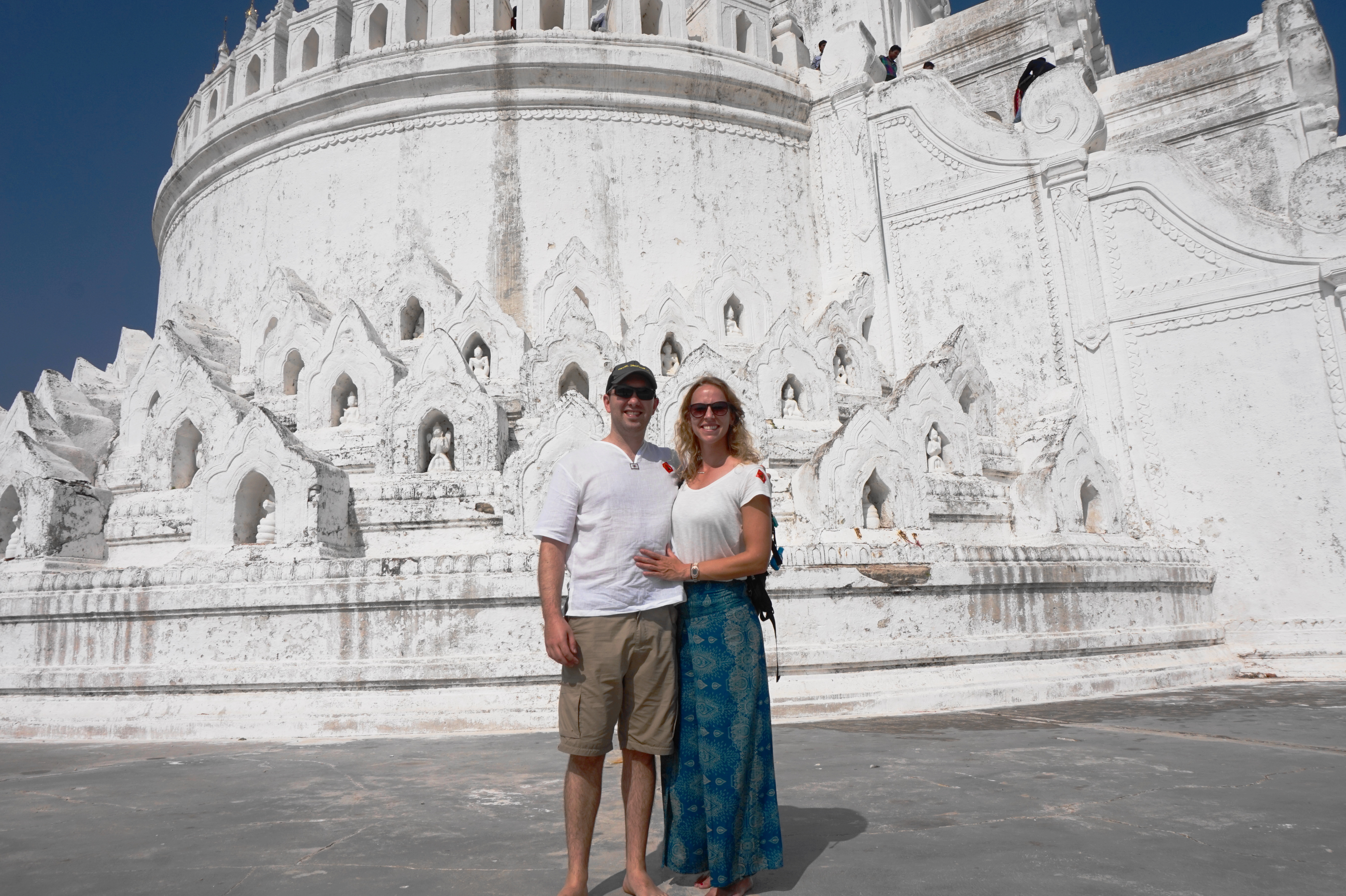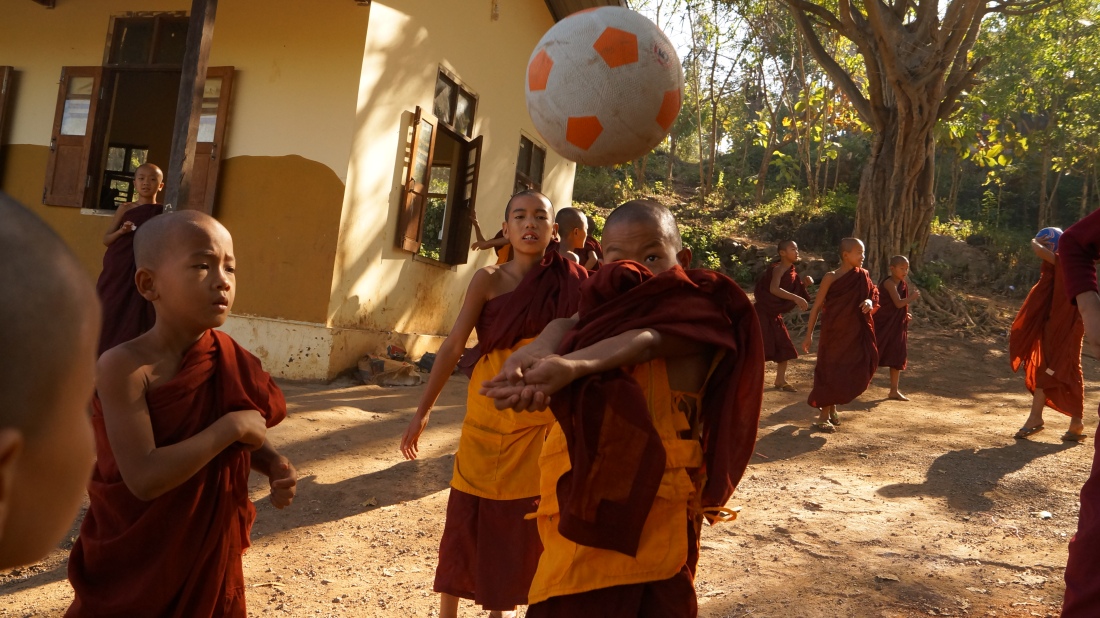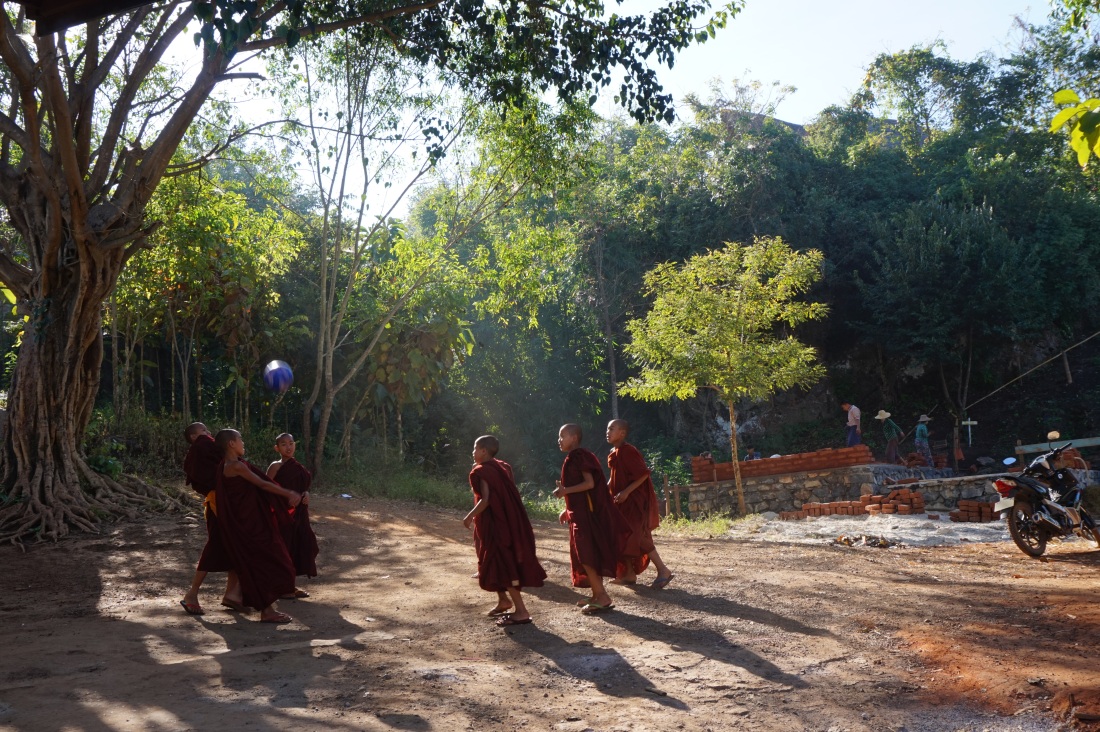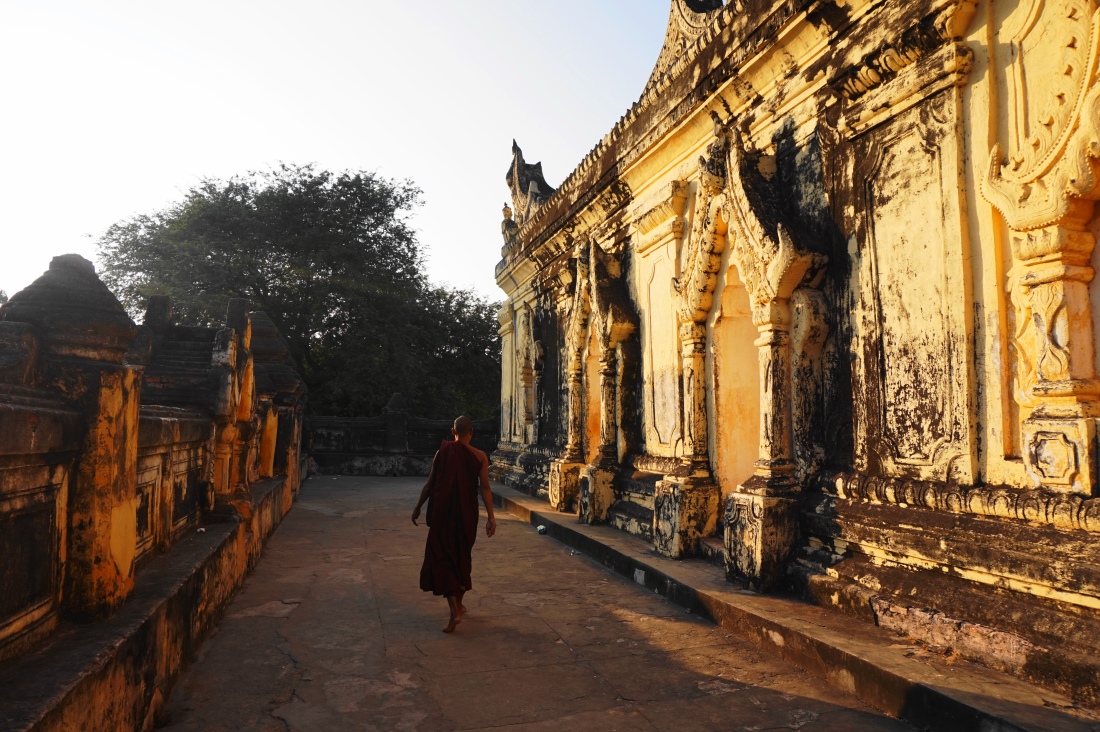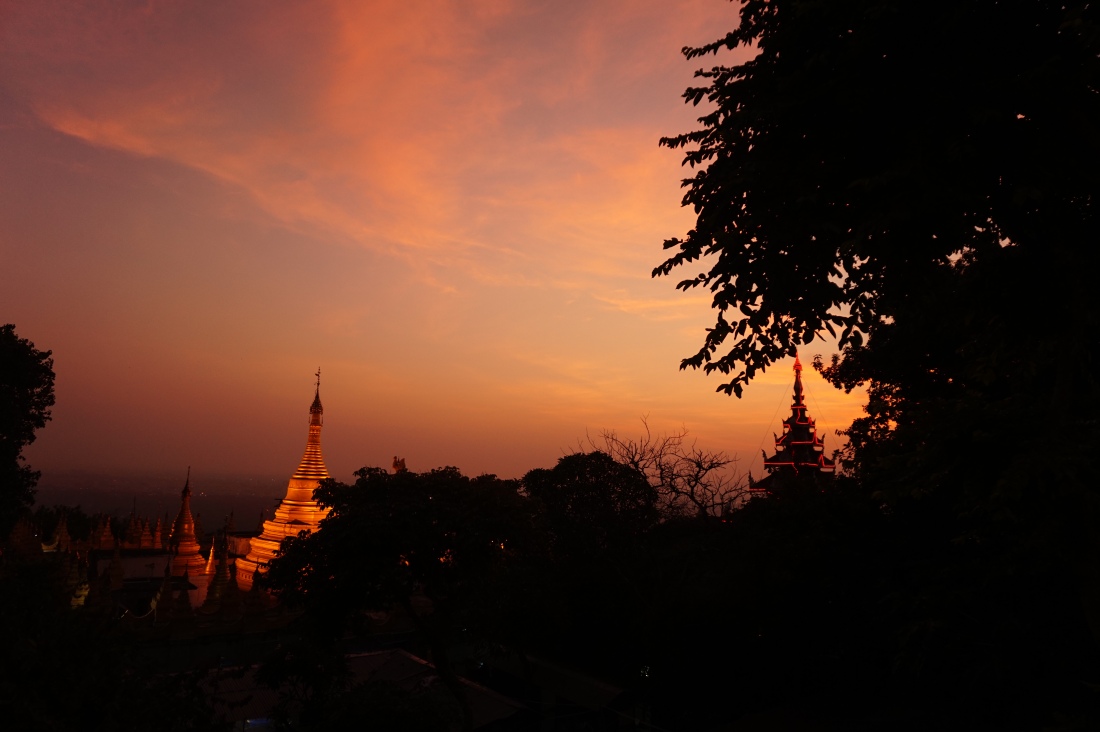A compilation of us being tourists in Myanmar. Check out our other Myanmar video for our time volunteering at a Monastery
Category: Myanmar
Magical Bagan
Nestled in along the Irrawady river, south of Mandalay, there is a town named Bagan. It is the withering vestige of a once great place. Its streets are rough and dusty, and it appears like an arid African landscape. The only life that can be seen are the pudgy tourists and the green trees that have found water deep below the surface. Dilapidated buildings line the crooked streets. It is the 21st century equivalent of the quintessential American Wild West town; John Wayne would have surely preferred a Honda Cub to a horse, given the opportunity. What lays just on the outskirts of town is something magnificent.
Thousands of pagodas and temples stand above the canopy of trees and stretch as far as the eye can see. This place is called the Bagan Plains and it is truly remarkable. The Burmese government has made it illegal for tourists to rent gas powered motorbikes. As a result, Ebike rentals have surged. Their maximum speed in 55 KPH and they’re completely silent. This adds to the experience of darting between the ancient structures on small dirt paths. It can be exhilarating and nerve-wracking as a trail can quickly turn to fine sand in a moment, leaving the EBike’s front tire hopelessly drifting. The freedom to get lost in a maze of incredible ancient temples with no other humans in sight is truly special. The experience will leave you in awe, though covered with dust and scratched from one of the countless thorn bushes. With the awe comes a nagging question: How did all of this get here? You’ll feel as though you are driving through history, and it turns you couldn’t be more right.
The ruins in this region are from the Pagan Kingdom which makes up a large portion of modern day Myanmar. Starting in roughly 800 AD, the kingdom began steadily growing. In the 11th century, the kingdom experienced its greatest success and tremendous growth. It flourished in the areas of philosophy, mathematics, science, ethics, law, and art with students traveling from all over the region to ancient Pagan. During the 250 years of prosperity, 11,000 pagodas and temples were erected in the Bagan Plains. Mother nature has beaten and crumbled the structures, with earthquakes, monsoons, and unrelenting sun. Today there are only 20% of the original structures remaining.
Every dog has its day, and every empire its night. As the Mongels swept through Asia, fear spread into the heart of the Pagan empire. The population evacuated and the promising city would never be the same. The beautiful structures that represented the kingdom sat in solitude and the city would never reclaim it’s potential. The name changed from Pagan to the current name of Bagan during later military rule.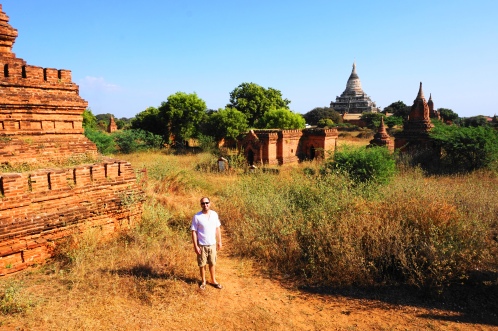
Fast forward to 1990 and the Burmese military government began an initiative to increase tourism to Bagan. They built a golf course and started repairs on the dwindling structures. Unfortunately, their attempts to foster tourism failed and resulted in inflamed local tensions. In present day Bagan, tourism is on the rise while the beautiful structures that draw the tourists continue to decay and the local infrastructure is stressed.
The key times to visit the Bagan Plains are at sunrise and sunset. You have two choices, participate in the legal viewing areas among the throngs of other tourists, or blaze your own trail for a more authentic experience. The first night we went to the viewing platform. Squeezed in between Chinese tourists with IPads or zoom lens the size of your arm, the peacefulness of the sunset was left to be desired. 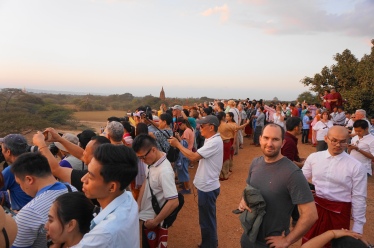
The following day we set out on our EBike in the hopes of finding an oasis of calm. Many of the temples have gates that do not allow people to climb onto their high terraces. To find one without, is a strike of luck. You first enter the dimly lit atrium and what sits before you is a massive Buddha resting with one hand touching the ground. You search for a way to ascend the structure, and notice a tiny opening tucked away in the corner. Measuring only 4 feet in height, a small stairway leads upwards to sunlight and the promise of a view. Squeezing inwards with back bent, you thrust yourself up the stairs, with the dusty walls clinging to your love handles. You emerge triumphant, and gasp at the fresh air as you orient yourself to this new vantage point. It’s beautiful, but you can do better. You scramble up the tiers of crumbling bricks to the top of the steeple, and finally, clinging to the edge, you get that awe inspiring view of hundreds of temples dotting the landscape.
Unfortunately, the one we found was also discovered by about 30 other tourists by the time we had returned at sunset. Opting for a quieter experience we set off to a different temple we had found. Our route was not the same, and we ended up biking through fields of thorn bushes before settling on a small pagoda to watch the sun set. With ripped pants, scratched legs, and bruised egos, the pain was soon alleviated by the majestic setting sun.
Although sunset is beautiful, the sunrise cannot be missed (so says Alayna as she drags Mark out of bed at 5:45 AM). Running late (because Mark didn’t actually get out of bed until 6:05) and with the sun starting to illuminate the sky, we raced on our EBike to a potential viewpoint. Arriving in the nick of time, we clamored up a massive pagoda with a slanted, deteriorating portion presenting us with a route up. Tucked behind the distant mountains, the sun slowly creeps upwards shining its vibrant rays across the plains. It feels like it can’t get any more beautiful, but then you hear the distant roar of a rising hot air balloon. Soon the sky is dotted with many colourful hot air balloons, peacefully floating across the backdrop of a rising sun, rugged mountains and exotic pagodas.
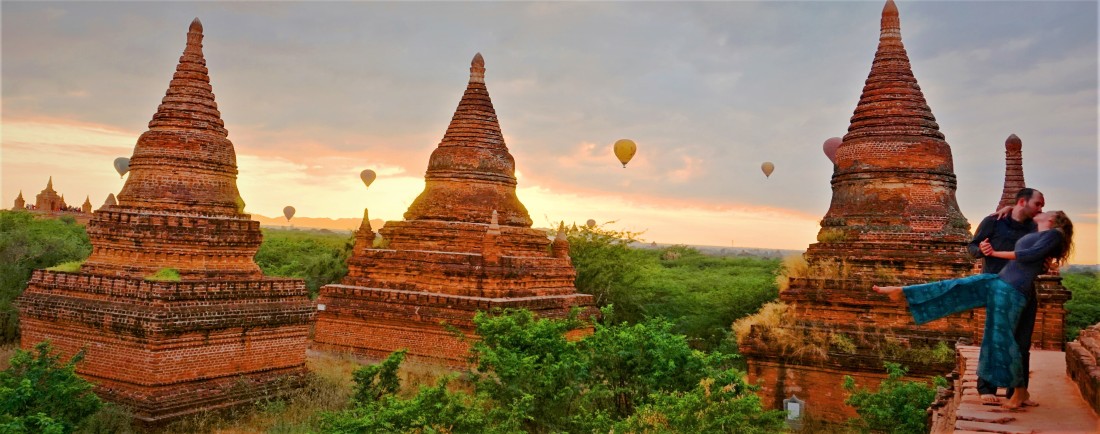
The excitement fades as the sun fully enters the sky and now the challenging part: how to get off this crumbling structure. The decent involves the muscles of a rock climber, the flexibility of a gymnast and the dexterity of a ballerina. We’ll leave that image to your imagination.
It was a beautiful conclusion to our 3 weeks spent in Myanmar. The people have been friendly, trust-worthy and genuine. The roads and transportation can leave you frustrated; even our mighty Ebike managed to let us down. Stranded at night on the outskirts of town, we were taken in by friendly hotel staff and back on our way in no time. Although it has the normal challenges that a developing country faces, the thanaka streaked cheeks of the smiling Burmese people leave you with hope for its future.
Mudita Video
Our experience volunteering at a Buddhist Monastery in Myanmar
‘Tis the season!
Thanks to some very generous Canadians we received 1600CAD in donations for the Monastery and the children. We weren’t trying to raise money but people offered and we were thrilled. The donors wish to remain anonymous but we can say they are part of our close circle of friends and family. It brings us joy that we have people in our lives that have such big hearts. This post will give a run down of how the money was utilized and the impact it will have on those receiving it. Enjoy!
After a day or so at the monastery we realized there were infrastructure and hygiene issues. This is due, in part, to a rapidly expanding community and an inadequate amount of funds being allocated to the less glamorous areas (hand soap, pumping systems, proper maintenance, etc.). Putting up a new structure feels and looks great; it allows donors to see their money in a single photo. What can quickly happen, however, is a growing population resulting in greater stress on the already insufficient infrastructure. It was our opinion as fiduciaries to put the money towards things that would reduce suffering by the greatest amount. That meant increasing education on hygiene and purchasing hygiene products that the children need. It also meant fixing broken systems and educating locals on how to fix their systems once we leave.
The last focus was increasing the comfort level for volunteers. The monastery’s greatest asset is the human capital that its volunteers bring. If someone isn’t sleeping, or if they’re sick due to poor conditions, then they are an under utilized asset.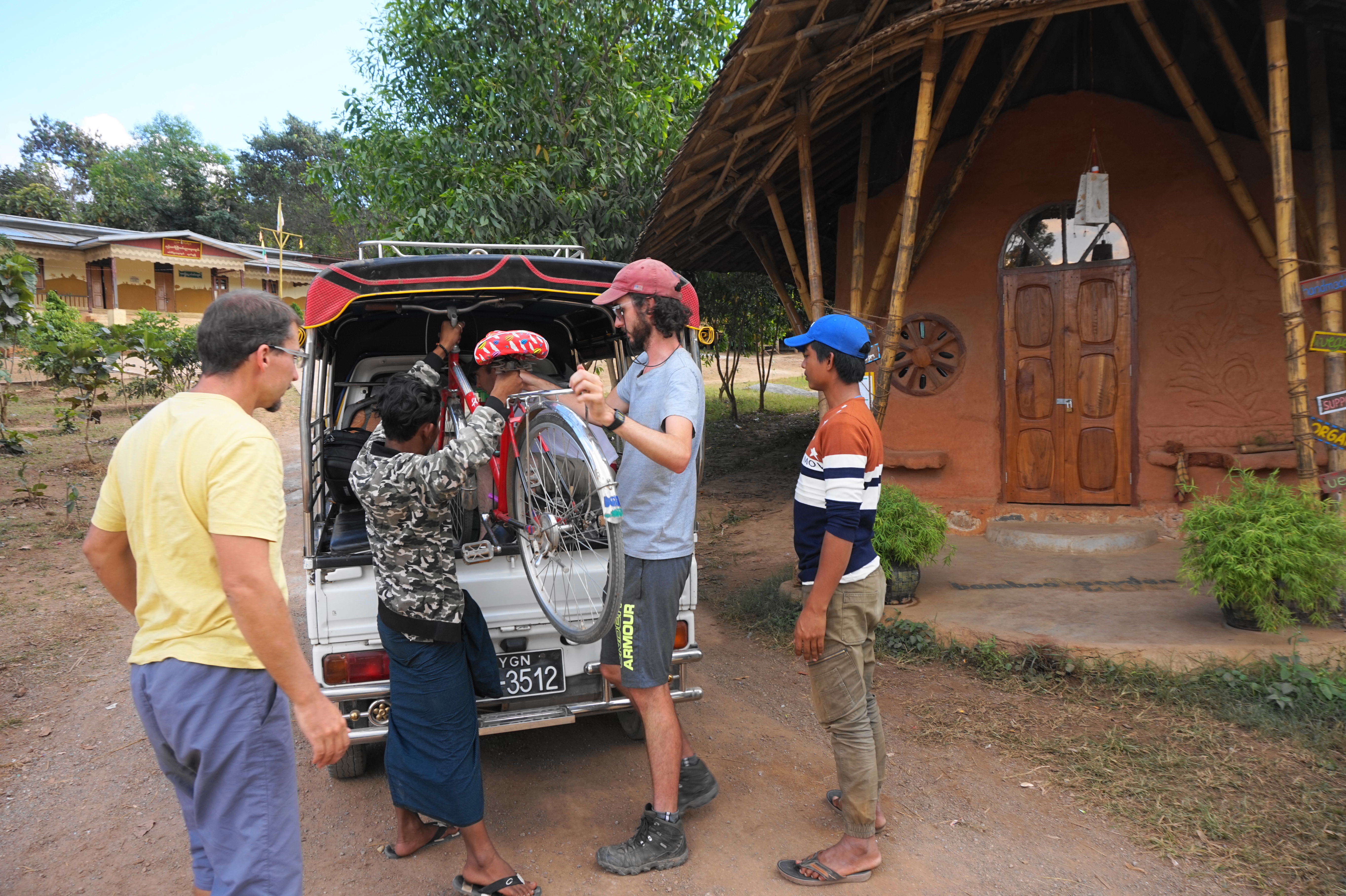 We tried to combat that by offering hot water bottles, kettles and more blankets for the cold nights. Large laundry bins that allow for washing of sheets and blankets (something that had never been done previously). We also bought three bicycles so volunteers could get to town without having to walk 45 minutes each way.
We tried to combat that by offering hot water bottles, kettles and more blankets for the cold nights. Large laundry bins that allow for washing of sheets and blankets (something that had never been done previously). We also bought three bicycles so volunteers could get to town without having to walk 45 minutes each way.
By talking to other volunteers, foundation organizers and teachers, we came up with a list of things that would help the children. The list was separated into different categories and that got us thinking of how to purchase all this stuff in the smartest way possible.Luckily enough, our group of volunteers (roughly 15) had rented a tuk tuk for Sunday to explore the area around the monastery. Connecting the dots we asked the volunteers if they would participate in a scavenger hunt in the local town. All agreed and we broke off into teams each with a wad of cash and a list of things to buy.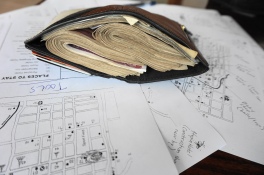 It worked exceedingly well and all those micro decisions that would bog down a single buyer were delegated to volunteers that knew what the monastery needed. The rules were simple: get the best price possible and return any unspent money. We had local prices written beside the list of items; this helped reduce “tourist” prices. What ensued was loads of fun with different teams using different techniques. Some would pile a mountain of goods at the shop keeper’s desk and threaten to walk if the price wasn’t reduced (you know, buying in bulk) while others meticulously noted every expense and haggled on each item. In the end, a third of the money donated was spent and in a very efficient way on teaching items, cleaning supplies, hygiene products, tools and building supplies and fun and games.
It worked exceedingly well and all those micro decisions that would bog down a single buyer were delegated to volunteers that knew what the monastery needed. The rules were simple: get the best price possible and return any unspent money. We had local prices written beside the list of items; this helped reduce “tourist” prices. What ensued was loads of fun with different teams using different techniques. Some would pile a mountain of goods at the shop keeper’s desk and threaten to walk if the price wasn’t reduced (you know, buying in bulk) while others meticulously noted every expense and haggled on each item. In the end, a third of the money donated was spent and in a very efficient way on teaching items, cleaning supplies, hygiene products, tools and building supplies and fun and games.
To spend the final amount of donation money we rented a tuk tuk for a day and got a group of volunteers to go to the main city, roughly one hour away. Again, we split into teams and broke off to find items like: vacuum cleaners, kindergarten mats, and other specialized things. At the end of a long day we returned to the monastery with two tuk tuks full of buildings supplies and random items.
Hygiene and improving health was our main priority. Alayna took care of the clinic’s needs by restocking supplies and purchasing missing medications. Proper body hygiene products like soaps, shampoos, toothbrushes were purchased along with everything needed to do laundry. New pillow cases, underwear, floor mats and blankets were purchased. We bought building supplies improve the cleanliness of the kitchen area with a new cement floor and building a new garbage area away from the fresh food (and dogs). A new building to store the children’s dishes in a sheltered area is already in the works. The children were very excited about the cool, new vacuum cleaner to use on the carpets.
We had the opportunity to go around to each classroom and individually handout goodies to the children. They were obviously more excited about the soccer balls than the pens, but every child had a huge smile as they received their toothbrush, soap, or new socks. They were excited and appreciative, it was a little like a Burmese Christmas for us!
Mark gave up his teaching duties to focus on improving general maintenance with our new tools. His replacement was a motivated and talented duo (German & French). He spent a few days working on the water distribution system for the monastery. The existing system barely worked and was completely manual, i.e. you had to manually turn on the three pumps to fill the ascending water reservoirs. This led to pumps burning out and often no water at all if someone forgot to turn on the pumps. The answer was to install float switches in two of the water tanks and automate the system. After a day of changing the wiring and installing controls, they fired the system up but no water came out! The PVC pipe that carried water from the river (through three pumps and a water tank) had no glue on any of the joints or couplings. The next day they tackled repairing the whole line. It was a tough, muddy day with more issues arising when one was fixed. Towards the end of the day the pressure was getting strong enough to blow open the couplings that weren’t glued. A geyser started forming from a pipe under the road, so they dug a hole and glued the final piece of the puzzle together. Looking up at the first concrete reservoir you could see fresh water blasting up into the air like a fountain. Success! Finally consistent water pressure and no more burning out motors! Nana ( the caretaker) gave Mark a high five as he celebrated.The monastery now has a reliable and automatic water system that holds clean river water.
Here is a list of what we purchased:
- Anti Fungals, Gloves, Antiseptic, Prescriptions, Dr visit, Shampoo, Soap, Multivitamins, Toothbrushes, Toothpaste, Spades, Saw, Screwdrivers, Electric drill/power tools, string, Pillows, Bed mats, Mosquito nets, Blankets, Sheets, Paper, Markers, tape, Skipping ropes, Volleyball/soccer, Candies, socks, Large tubs, Washboard, laundry detergent, Dish soap, Sponges, Scrub brushes, Clothesline, Bathroom cleaning products, Mops/bucket, Toilet paper, Hand soap, Vacuum cleaner, Whiteboard markers, Magnets, Notebooks, Highlighters, Whiteboard erasers, Tape, Posters, Float switch, Electrical wire, Disconnect switch, Electric kettle, Hot water bottles, PVC pipe, PVC glue, Insect repellent stuff, bicycles, computer supplies, cement, building supplies, roofing, garbage bins, floor mats, underwear, feminine hygiene products – and more random things that we can’t think of!
We would like to thank those of you who donated and the other volunteers that helped us along the way! We will post photos of the new buildings being built with the donated materials. You can also look at the Mudita Foundation’s website: http://muditafoundation.de/
Teach a man to fish…
We have spent the last 2 weeks in a whirlwind of activities at a Buddhist Monastery and school, Htet Eain Gu, which is why our posts have not been as regular. Our days are filled from the moment we get up at 7AM to the time we go to bed. Our naive thoughts that maybe we’d have some time to relax here couldn’t have been more wrong. Although some of that is from our own doing.
Alayna started teaching Grade 2 and 3 English this week. It’s challenging coming up with a lesson plan, and usually nothing goes as planned. It requires a lot of improvisation, as you never know if they will have their books, pencils, or if you’ll be able to use the classroom. Alayna’s favourite class involved teaching articles of clothing. She put together a bag of some of our older clothing and went to the playground. They did a scavenger hunt for various clothing items and then made two young monks dress in Mark’s shorts and shirt. They thought it was the most hilarious thing and laughed for close to five minutes straight. Even the local teacher was laughing.
In the afternoons Alayna works in the clinic. She started an anti-fungal shampoo regime to help combat some of the scalp fungus. She has taught the local clinic helper about the different types of fungus and created education and reference materials for future volunteers. A few of the worst cases (she drained about 20 abscesses from a young girl’s legs) she took with the local helper to the hospital to get oral medication for treatment. From this exchange a local doctor has volunteered to come to the monastery in a few weeks to see all of the children. Success!
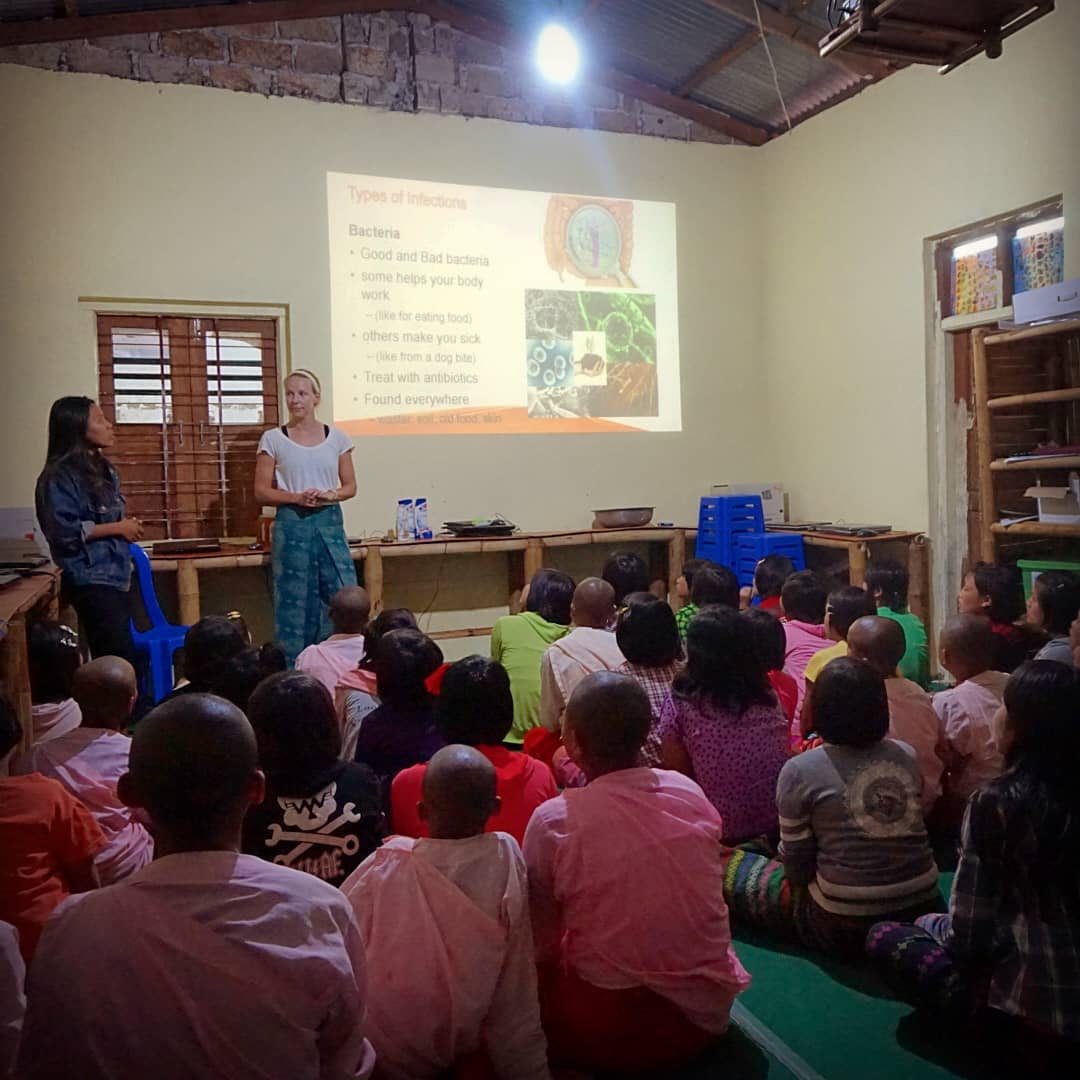
Alayna has also done presentations to the older children and some of the monks and teachers about infection prevention and control (how and when to wash hands, laundry, and how germs spread etc.). As part of the donations we are improving this by building new buildings for the garbage, to house dishes and a laundry washing station.
Mark has been working hard to better the infrastructure and working conditions at the monastery. A large portion of his time has been put into figuring out how to use the donation money effectively. After this was taken care of, he worked on improving their water management and pumping stations. No small feat, as a small task can turn into a major one with hidden problems along the way. He managed to fully automate three water tanks, repair all the water lines, clean out the pumps and tanks, and educate the local caretaker (a VERY tough lady named Nana) on how to properly upkeep them. He’s also crafted many handmade solutions to simple problems here. A shower our of old bottles, bamboo railings up a steep path, and bamboo shelving units.
Last weekend we decided to take a break from our accommodations and rented a hotel in town. A hot shower has never felt so good. We did a day boat trip to Inle Lake to see the stilt villages, and some of the local handicrafts like creating fabric from lily pad stalks, cigarette making, and silversmiths. It was a very touristy experience and we were ready to head back to our Kuti (house) to be back with the locals.
That was until we came back to a poisonous scorpion in the bathroom and the biggest spider our Australian roomate had ever seen living under our toilet. Eventually the 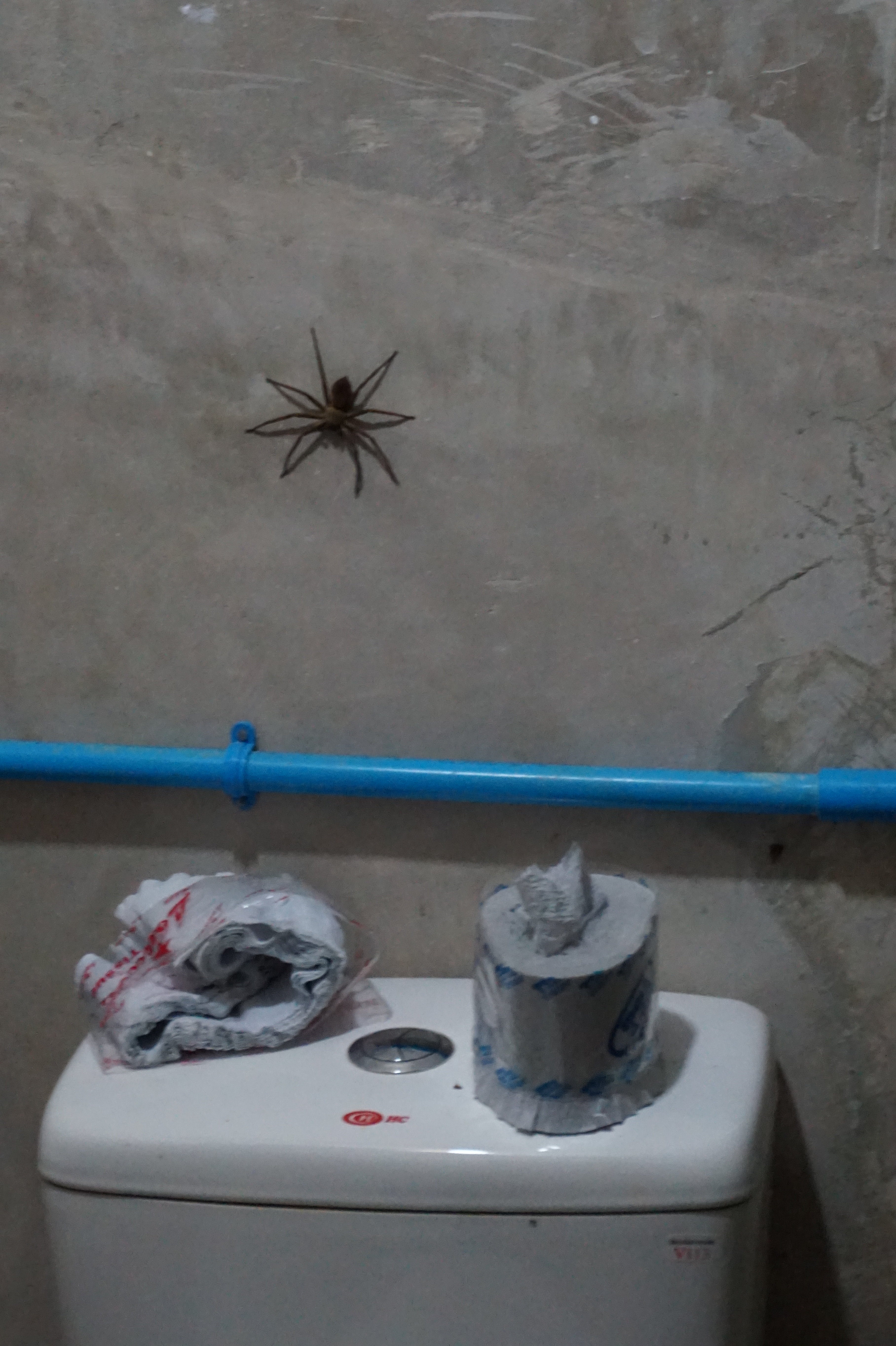 scorpion left the washroom; it’s still unknown if he exited a window or chose more permanent accommodation inside our Kuti. We named the spider Carl and he continues to live there, but at least he keeps the number of bugs down.
scorpion left the washroom; it’s still unknown if he exited a window or chose more permanent accommodation inside our Kuti. We named the spider Carl and he continues to live there, but at least he keeps the number of bugs down.
We were very lucky that we had an amazing group of other volunteers from around the world (Germany, France, Italy, Peru, Netherlands,Croatia, Australia, Czech Republic, etc.) who made the experience fun even in some of its most challenging moments. The experience was almost like camp, with fast friends forming due to circumstance. We even sang campfire songs. We are hopeful we can stay in touch with them in the future as we all travel around the world.
Now, we leave and continue on to our next adventure. It is sometimes difficult to see the impact you have made, especially in such a short time. Our goal was to give them the tools to improve their surroundings and through education and supplies, we believe we did that. It’s up to them to take what we have given and run with it. It was also a huge learning experience for us, and an amazing one. We’re sad to leave but we will continue to be in touch with the “Mudita Family” to view their progress.
ကျေးဇူးတင်ပါတယ် (thank you!)
Let’s get down to business
Vacation time is over and work has come abruptly. This is an update of what we’ve done over the last week. Enjoy!
In the hills surrounding Inle Lake in Central East Myanmar there is a Monastery named: Htet Eain Gu Monastic Education School (pronounced Tay en goo). It houses roughly 200 children, ranging in age from four to 14 and teaches classes from Kindergarten to Grade seven. The children here are sent in from neighbouring communities for numerous reasons. Some are orphans, others are too poor for school and some are being sent away from conflict ridden regions. The Mudita Foundation has recently taken over the Monastary and since then has implemented various projects such as farming, mud brick making, a cafe, and educational services. They have established a rotating volunteer community with helpers coming from around the world. Many of these volunteers help teach the children subjects ranging from Art to English classes while the remaining ones help with the formerly mentioned tasks.
We arrived on Sunday after a dangerous and draining drive from Mandalay; I don’t think we’ll ever get used to them. The celebrations from the full moon and light festival were still taking place and lasted until Tuesday (Nov. 20) night. Part of the celebration is dressing in traditional Burmese clothing and lighting lanterns. They carry a string of lit candles up a hill to a pagoda, being followed by a band of local young men carting around a huge drum and banging things while singing. They made a large quasi Christmas tree thing that they hauled around on their shoulders. The creation was filled with buckets, cleaning supplies, money, random objects, and was topped with an umbrella from which money was attached. These were offerings to the monks.
The children had Monday and Tuesday off from school, so we were itching to do something. Tuesday we were sent to work making mud bricks out of clay. The bricks will eventually be used for a new building they hope to build. It’s messy work as you need to mix the clay with rice husks and straw using your feet, but satisfying nonetheless. In the afternoon we were sent to the fields and tackled tilling and plowing the land with hoes. Not as satisfying and far more tiring. Unfortunately, (though as expected) our accommodations do not allow for a good night’s rest. We were on a thin mat atop a concrete floor, covered by a mosquito net (that does not work well) and with thin blankets for the <10 degree Celcius nights. We put on all the layers of clothing we can possibly scrounge before going to bed. If the cold that creeps into your bones isn’t enough, then there is a dog pound with more than 200 dogs no further than 200m away from our kuti (mud house). The slightest noise will trigger them into a barking frenzy; this occurs multiple times per night. At 4:30 AM a Gong chimes to wake the monks for their journey into town to collect their breakfast donations. No need to worry though, you wake yourself up quickly enough with your “shower” consisting of a bucket of freezing cold river water.
So, why in the heck are we subjecting ourselves to this? Well, because just maybe we can make a difference in these children’s lives. It’s as simple as that. You come looking for an experience and an insight into another world but what you find are children that truly 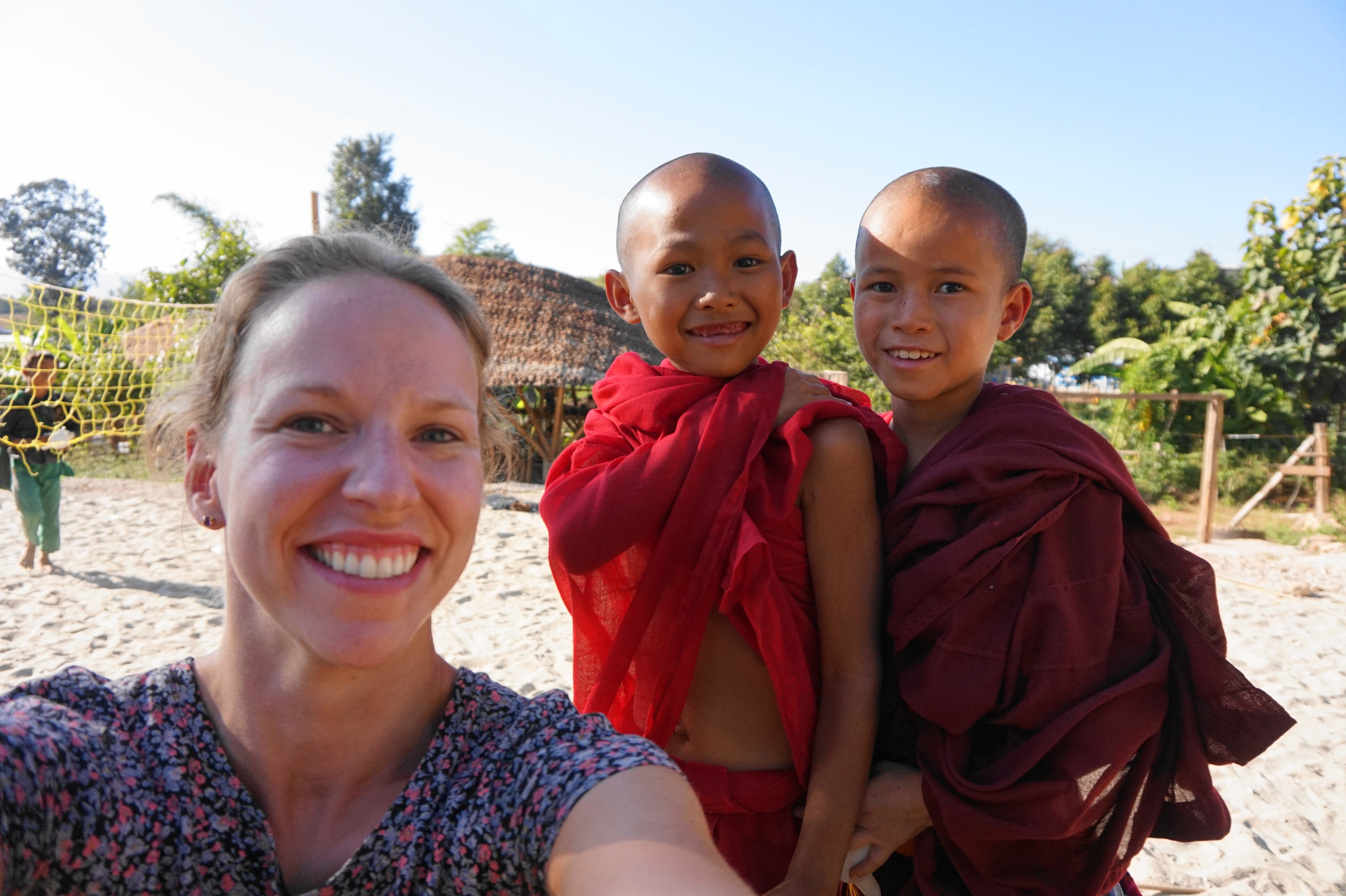 need help. Children that plagued with excuses and bad attitudes. Children whose poor fortune has left them in a situation where life is hard on all fronts. For any decent Canadian this will spur you into action, helping with any and all skills you possess. It will also leave you profoundly thankful for the quality of life enjoyed at home; often we contribute such a small portion relative to the massive yield we receive – take a minute to be thankful for your forefather’s blood, sweat and tears that built a successful environment in which you can thrive.
need help. Children that plagued with excuses and bad attitudes. Children whose poor fortune has left them in a situation where life is hard on all fronts. For any decent Canadian this will spur you into action, helping with any and all skills you possess. It will also leave you profoundly thankful for the quality of life enjoyed at home; often we contribute such a small portion relative to the massive yield we receive – take a minute to be thankful for your forefather’s blood, sweat and tears that built a successful environment in which you can thrive.
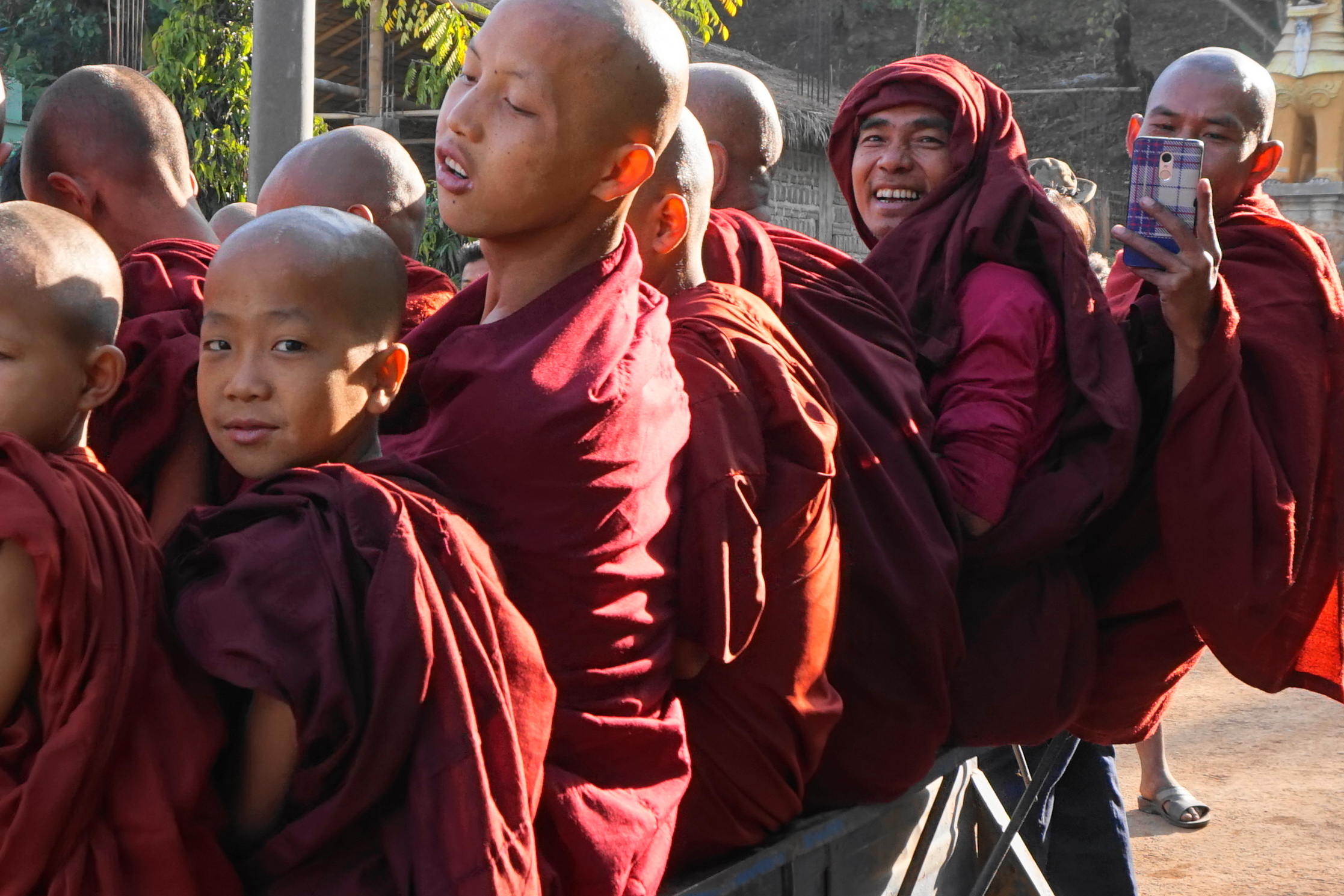
Alayna is teaching a Grade 2 class. The first day was a little overwhelming because she had only learned that she would be teaching them the night before. She got to the class and 22 children, in small wooden desks, were staring back at her. The only separation from the adjacent classrooms was a whiteboard. The noise was deafening. The children sing, chant or repeat sentences at the top of their lungs, and the concrete walls create a wonderful echo chamber. So, having four grades in the same long hall make it nearly impossible to distinguish voices or teach. Alayna was shouting at the top of her lungs “THE CAT IS ORANGE. THE CAT IS ON THE TABLE!” and was met back with blank stares, or distraction caused by a puppy that wandered into the classroom. The solution? Take them outside. Alayna was able to teach them about certain animals names, their colours, and where they are (above, below, beside). She started acting out the animals and climbing things, crawling under platforms, “The MONKEY is UNDER the TREE”. They look at her as if she is crazy, but eventually she gets them to join in and they’re all monkeys above, below, beside things. Alayna left feeling exhausted and voiceless. She had another class today and was much more prepared. After the class the children high-fived her. We’re getting better.
In the afternoons Alayna is in charge of the health clinic. The main problems are to do with the skin, particularly fungus. The children live in very close quarters (50 girls are in a house the size of a bungalow back home) and they rarely (if ever) wash their linens. This is exacerbated further with the monks, because they shave their heads weekly, the small cuts leave them vulnerable. They end up with patches of fungus on their heads and other parts of their bodies. Some of them have particularly bad fungus on their feet that has caused ulcerations (caused from walking barefoot in the dirt). Alayna has made an action plan, been to the pharmacy, and am giving a special presentation next week on general hygiene, fungus and what they need to do to combat it. She doesn’t think it will fix everything, but hopefully we can minimize it as much as possible.
Mark is teaching Grade 7 English in the mornings. The class lacks discipline which results in constant distractions to all the children in the classroom. Their common age is in no way indicative of a common skill level. Many can barely speak or read while others are able to converse with basic sentences. Finding common ground is difficult if not impossible. English games seem to have the greatest appeal and draw the shy students from their solitude. It can be daunting in these situations as so many things are stacked against the teacher and student’s success.
In the late morning Mark is tutoring two monks and two locals. Their age range is from 18 to 26. Lessons focus on conversational English and pronunciation. These students are eager to learn and absorb information like sponges. Due to this Mark has started a second session in the afternoon to maximize the time spent with these students. There’s no joy like teaching a motivated student, any teacher can attest to that.
Mark is also doing various building projects around the Monastery. First was building a bamboo dresser so our clothes wouldn’t have to sit on the floor. Next was an infrastructure upgrade to the stairs leading to our kuti. The path snakes up a rocky face with loose dirt and stones laying on the trail. After acquiring some German talent they began fashioning bamboo hand rails, re-leveling the steps and fixing old portions of the trail. It’s satisfying work and benefits all those who use the path daily.
There are some big challenges here. We, along with the other volunteers from around the world, are optimistic that we can do some good. If we weren’t, then we would definitely choose to be in a place with an actual bathroom. Changing local attitudes and customs can be very hard. We are trying to implement better hygiene measures and practices but high volunteer turn over makes that seem like wishful thinking.
We have received a significant donation (500CAD) from Mark’s friend (they wish to remain anonymous) to be administered by us as we see fit. We are putting together a plan regarding the funds. We will share how the money is spent and some of the reactions from the beneficiaries.
If you would like to donate in a similar manner then we could act as fiduciaries with our word that 100% of your donation reaches those in need. This isn’t a fundraising campaign. It’s an opportunity to give with an assurance that the funds will be used wisely and ethically. We have both wanted to give before but have been dubious about the efficacy of company’s claims. There would be no tax receipt. Money goes a long way here – 30CAD bought: anti fungal cream x 9, loads of hand soap, anti bacterial cream, and various medicines. If you would like to participate in some way then please contact us!
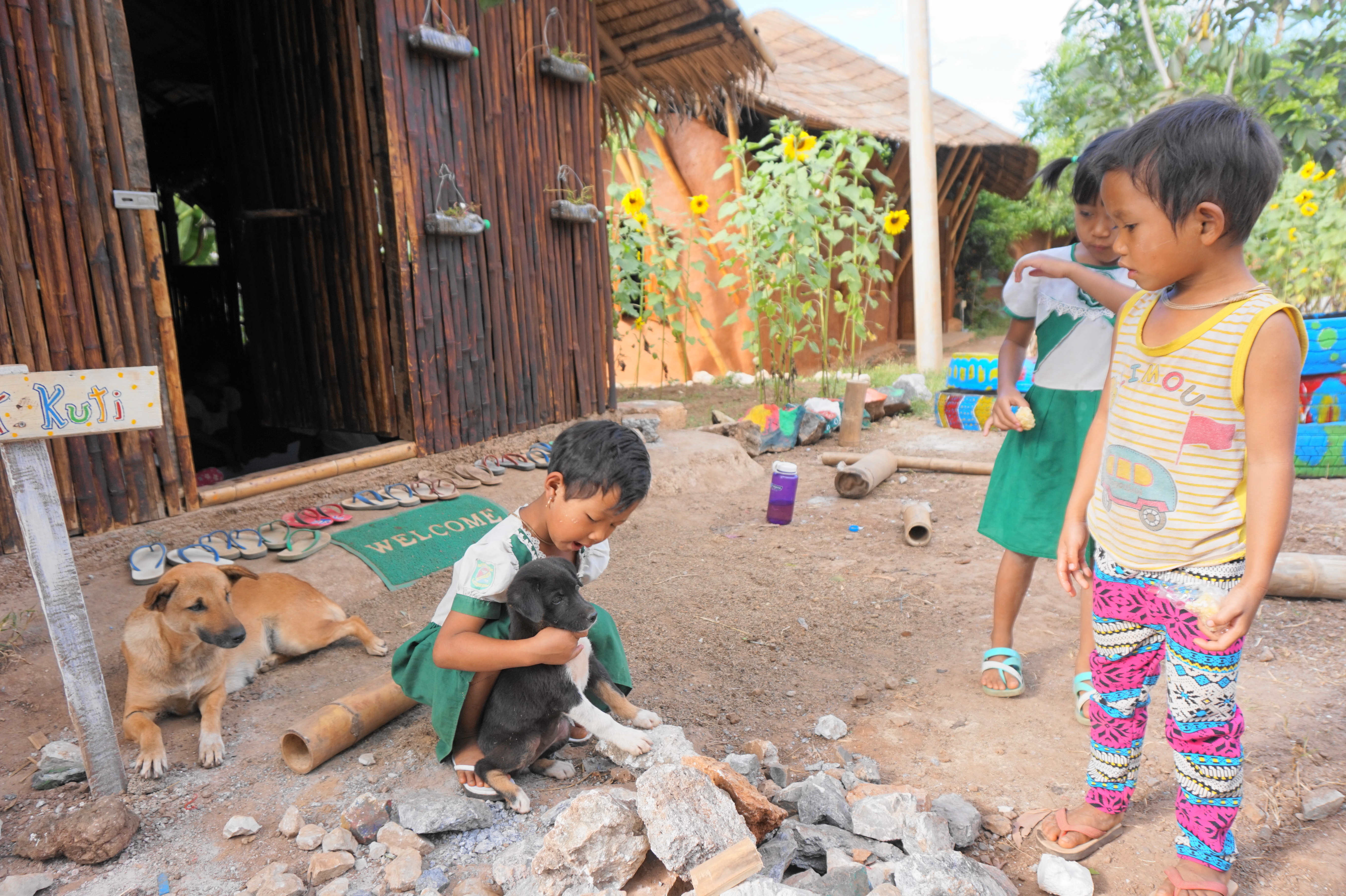
Monk-ey Business
Buddhism is practiced by 90% of the population in Myanmar and has been practiced here for over 2000 years. Buddhists focus on the teachings of Gautama Buddha. He’s that serene, calm looking man sitting crossed legged found across most of Asia; the rotund, gold, bald one you’ve seen at your local Chinese restaurant is his future reincarnation. He was a monk who took to the practice of meditation to understand suffering, death, rebirth and karma. It is said he achieved Nirvana and enlightenment; thus beginning his teachings and Buddhism was born. The main ideas are to achieve personal spiritual development. This in turn helps to overcome suffering caused by endless cycle death and rebirth.
Monks and Monastic schools are all over Myanmar. You cannot walk down the street without seeing at least one of them, their shaved heads bouncing around in the back of a pick up truck with all the other locals. They wear maroon or orange coloured robes, with the nuns wearing pink. Monastic schools have a long history in Myanmar, but today they are primarily used to supplement the government education system by providing basic education to under-privileged or orphaned children, many from very remote areas of the country. Their fees are payed by donation and whatever their parents are able to afford.
We met a monk-in-training (named Jerry) on Mandalay hill (a lookout point) who invited us to his school. There are over 1200 monastic schools in Myanmar, teaching over 100,000 kids. His school houses 8000 of them. It’s a fairly large building and receives a large portion of it’s donations from companies in Germany and Australia. Still, it’s in pretty rough shape, with 15 kids per bedroom, small desks and broken windows. The kids look happy and have an amazing ability to tie their robes to create many different outfits. We will have more insight after the next few weeks after our own teaching experience at a different school.
All across the country people are happy and excited; it’s party time! Tazaungdaing festival (also known as the lights festival) is held on the full moon day in the eighth month of the Buddhist calendar. It marks the end of the rainy season and is celebrated across the country as a national holiday. People celebrate with robe weaving competitions, lighting candles and releasing hot air balloons. On a smaller scale, children and families line the streets asking for donations to prepare a feast and go to pagodas across the land to pray.
The actions taken to get donations vary from nothing to quite elaborate. There is simple shaking of a silver dish to dressing up in large paper-mâché outfits. Elephants, turtles, and odd looking fat people dance on the street trying to get people passing by in cars to throw money at them.
Many people do throw small bills (100 kyat- 5 cents Canadian) at them as they blow by on a motorbike. Others will draw a rope and make a barrier across the road, only relenting after a few moments of loud honking.
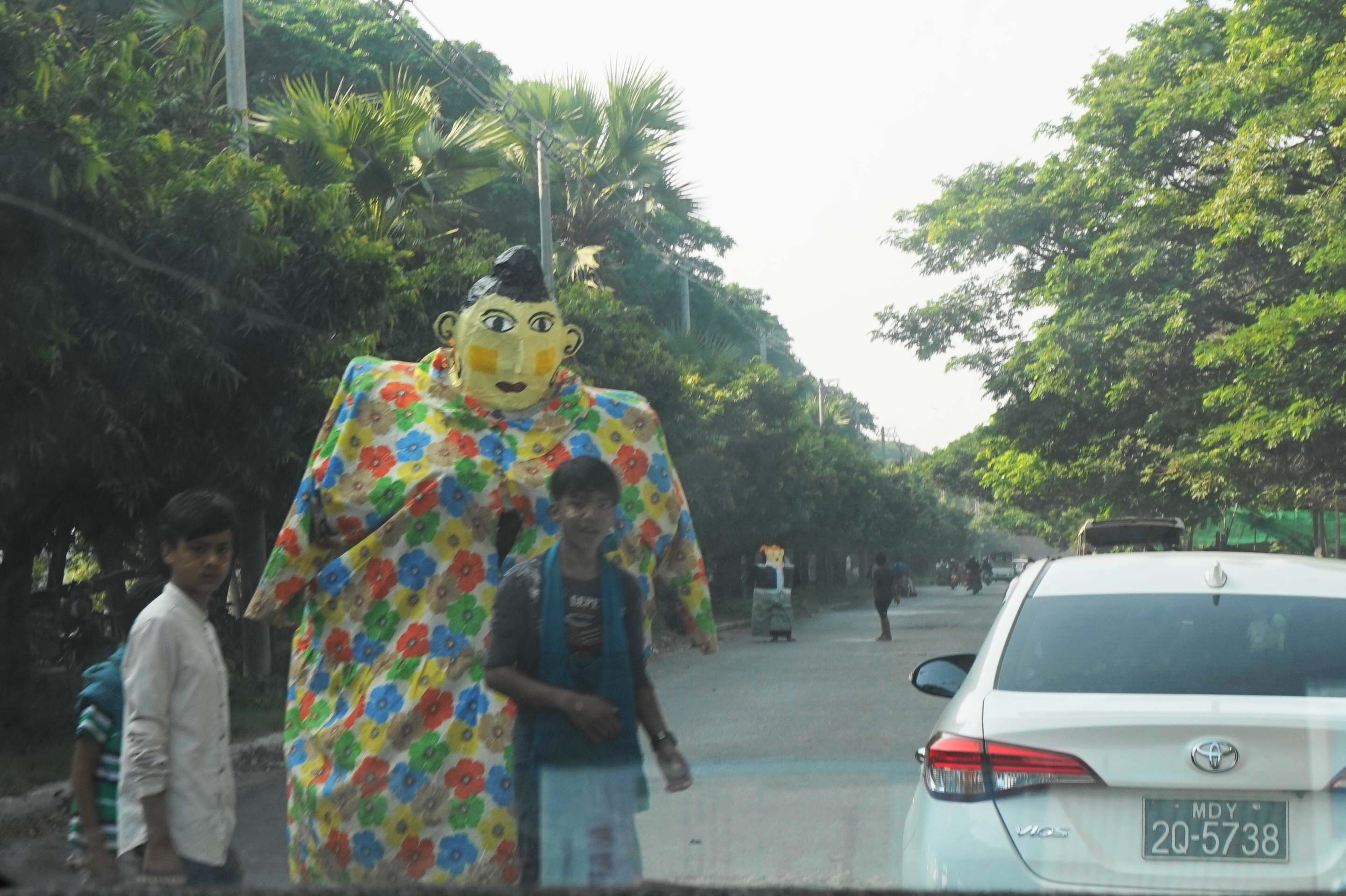
We arrived to Myanmar just in time for the party, though little did we know. We arranged for a driver to take us to many of the highlights of Mandalay and surrounding areas. The roads were lined with people and this made the journey both very entertaining, and very long. Our poor driver was tasked with navigating between elephants, darting children, wild dogs and hoards of people swarming to the pagodas.
Now in most places going anywhere touristy on a National Holiday would be a nightmare, but here it was a spectacle. There are definitely very few tourists here. Most fly in and go straight away to some temples on the river ( where we’ll go there in a few weeks), but few stick around Mandalay. This means that the vast majority of the people were locals who were practicing their own traditions.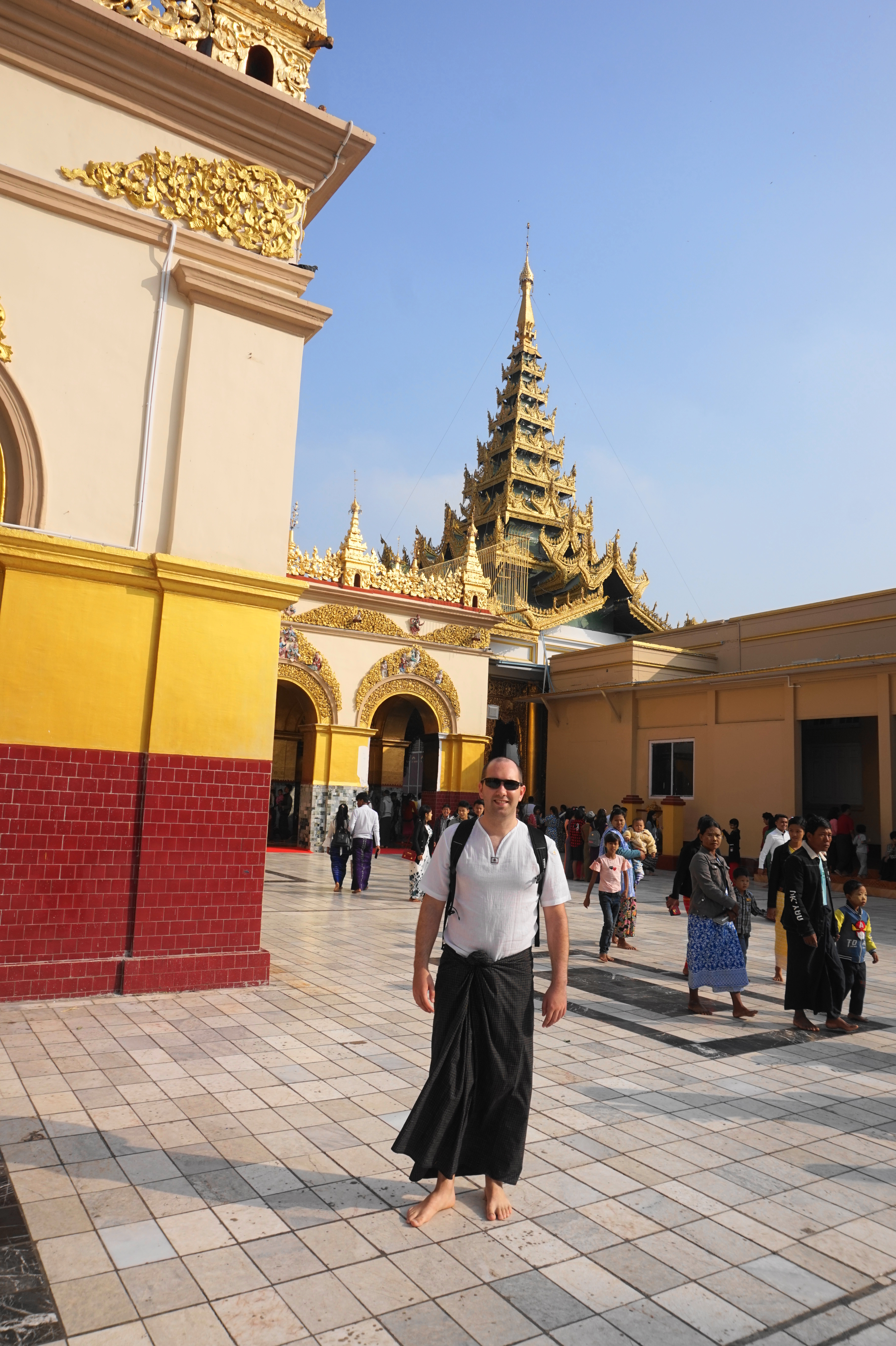
They are decorated with beautiful skirts, and their smiling cheeks are smudged with thanakha, a tree bark paste that is both for beauty and sunblock. 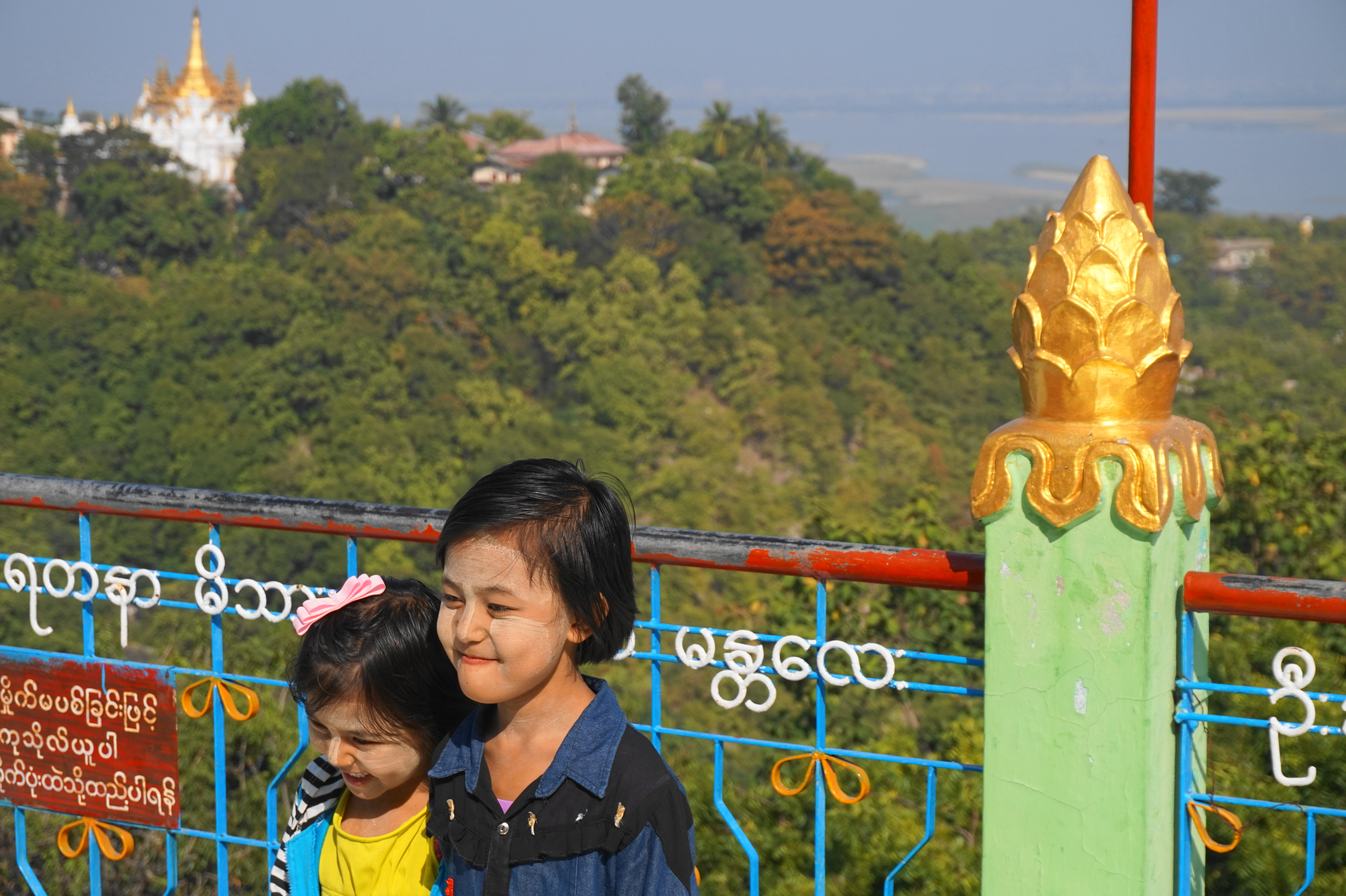 They were happy to see us as well, with many stares throughout the day and a few brave souls coming up and asking for selfies. What is not so beautiful about them is their teeth. They chew betel nut, which is somewhat similar to chewing tobacco that is mixed with some spices and rolled up in banana leaf. The issue with this is that it stains your teeth a dark reddish black that make it look like they could fall out at any second. I don’t have a photo of that yet; it’s a little awkward asking if you can take a photo of someone’s teeth. I’ll have to be sneaky about it… I’ll keep you posted.
They were happy to see us as well, with many stares throughout the day and a few brave souls coming up and asking for selfies. What is not so beautiful about them is their teeth. They chew betel nut, which is somewhat similar to chewing tobacco that is mixed with some spices and rolled up in banana leaf. The issue with this is that it stains your teeth a dark reddish black that make it look like they could fall out at any second. I don’t have a photo of that yet; it’s a little awkward asking if you can take a photo of someone’s teeth. I’ll have to be sneaky about it… I’ll keep you posted.
Myanmar promises to be an extremely interesting adventure.
Burma: The place you’ve never known
Disclaimer: This is intended to be unbiased and completely nonpolitical. I encourage readers to do their own research on this interesting subject.
It’s hard to know where to begin with this place. There’s a long, rich, and geopolitical history that makes up what this country is today. I don’t have the liberty to discuss certain topics but I encourage the reader to do their homework. Life is complicated and humans have a propensity to group and logically sort to make sense of the world. You’ve probably heard of Myanmar/Burma. You probably need to know more about it. Let’s walk this road together.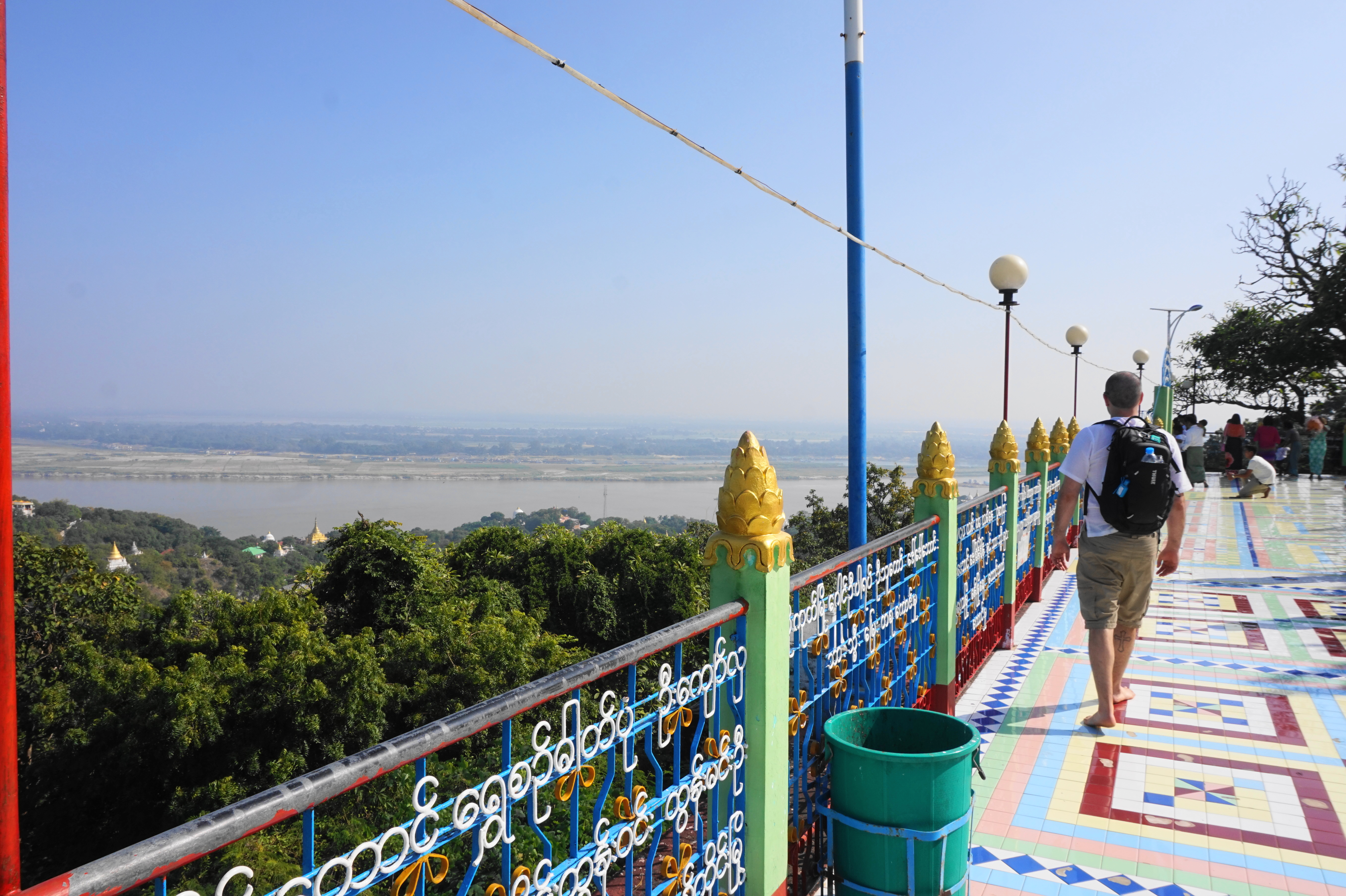
Burma, or as it is officially known: Myanmar, is a Southeast Asian country that borders Bangladesh, Southern China, and Thailand. It has a majority population of ethnic Burmese and numerous ethnic minorities. People have been on the land that makes up Myanmar for millennia. There are incredible archeological sites that encapsulate the longevity of the civilization that has been here. Various kingdoms came and went; borders expanded and withdrew in the same manner.
European contact started with the Portuguese in the 17th century and forever changed the country. The Portuguese never held or ruled in any significant way. The British, however, entered the picture in the mid 1800’s and remained around for nearly a century. Three Anglo-Burmese wars were fought with the British emerging as the victors despite suffering major losses. British India, which includes modern day Bangladesh, was directly adjacent to Burma. Holding Burma offered a port between Calcutta and Singapore (these things are important when you’re an empire) and could be governed by resources already present in British India. These factors were the impetus behind Brittan’s colonization of Burma.
If you’ve followed the blog then you’re familiar with the Japanese conquest of Singapore. Burma met a similar fate but was never fully conquered. That’s in no way an understatement of the atrocities that happened during the invasion as there were many. Post WW2, the seeds of doubt that had been sown began flourishing. Burma wanted independence and eventually gained it. Britain’s empire had been dealt so many blows that it would never be the same and withdrew from its centuries of global domination to attend to urgent matters at home. Burma had the daunting task of governance and running a country in a power vacuum; a difficulty that is all too often overlooked. In an effort to take control of their identity they de-anglicized many of their city’s names (Rangoon to Yangon – r’s aren’t in the Burmese language) and, indeed, their country’s name too (Burma to Myanmar).
Present day Myanmar: times are changing and tourism is on the rise. Foreign investment is coming from various places with a majority stakeholder being China. Cities like Mandalay are developing into modern metropolises. The growing pains are evident and inevitable to some degree. The Burmese are happy people that smile and wave at foreigners.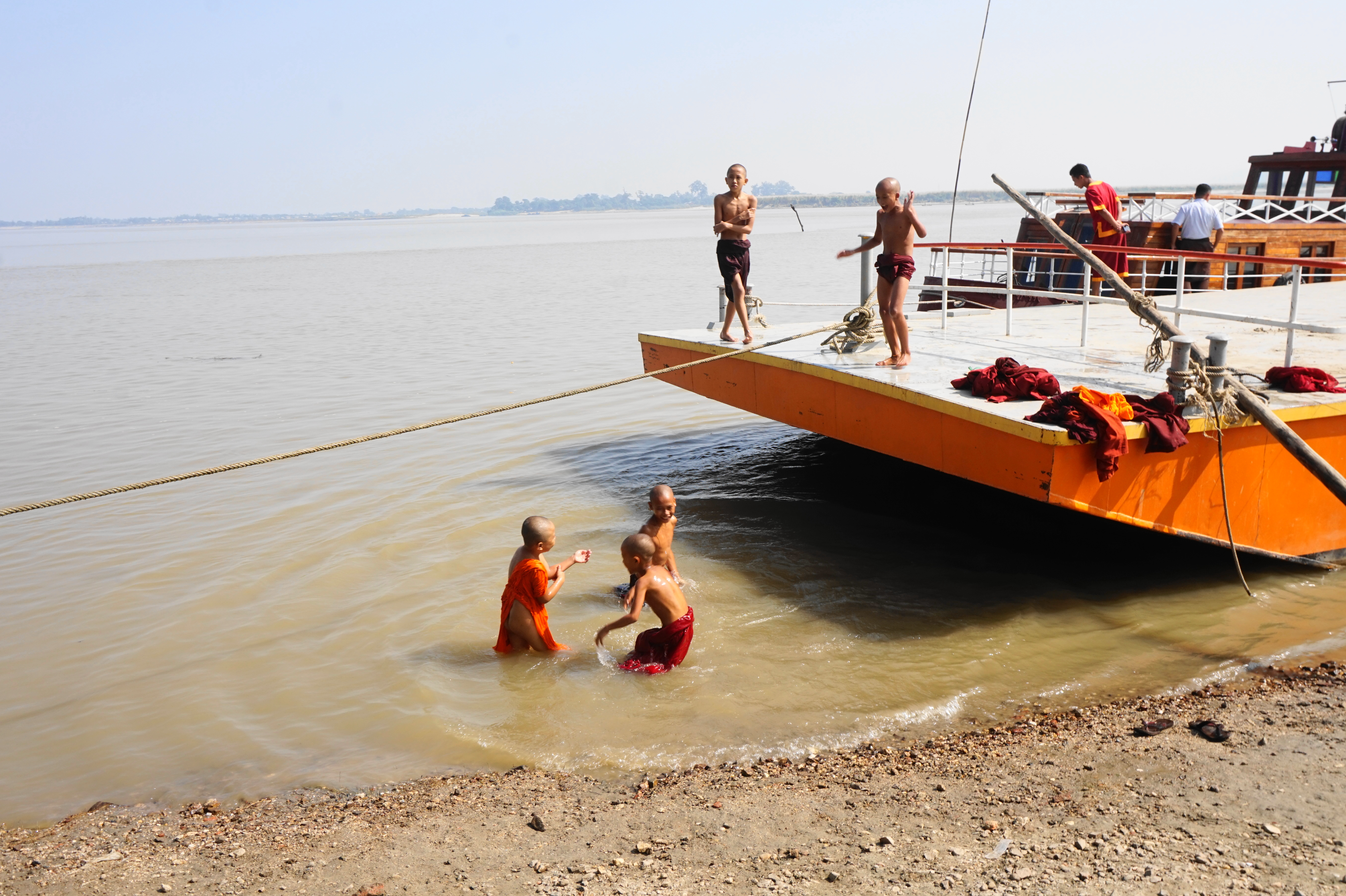 There’s a genuineness about them that’s seldom found traveling in the 21st century. Monks can be seen wandering the streets and will never waste an opportunity to practice their English. The younger generation have fully accepted advancing technology (this can pretty much be said about the monks too) and are as glued to their phones as any teenager in the West. Their embrace of the selfie is no less; we’ve been asked on multiple occasions to be in photos or just pose. One night we stumbled upon a bar called “Las Vegas” which was packed with locals almost all of whom
There’s a genuineness about them that’s seldom found traveling in the 21st century. Monks can be seen wandering the streets and will never waste an opportunity to practice their English. The younger generation have fully accepted advancing technology (this can pretty much be said about the monks too) and are as glued to their phones as any teenager in the West. Their embrace of the selfie is no less; we’ve been asked on multiple occasions to be in photos or just pose. One night we stumbled upon a bar called “Las Vegas” which was packed with locals almost all of whom 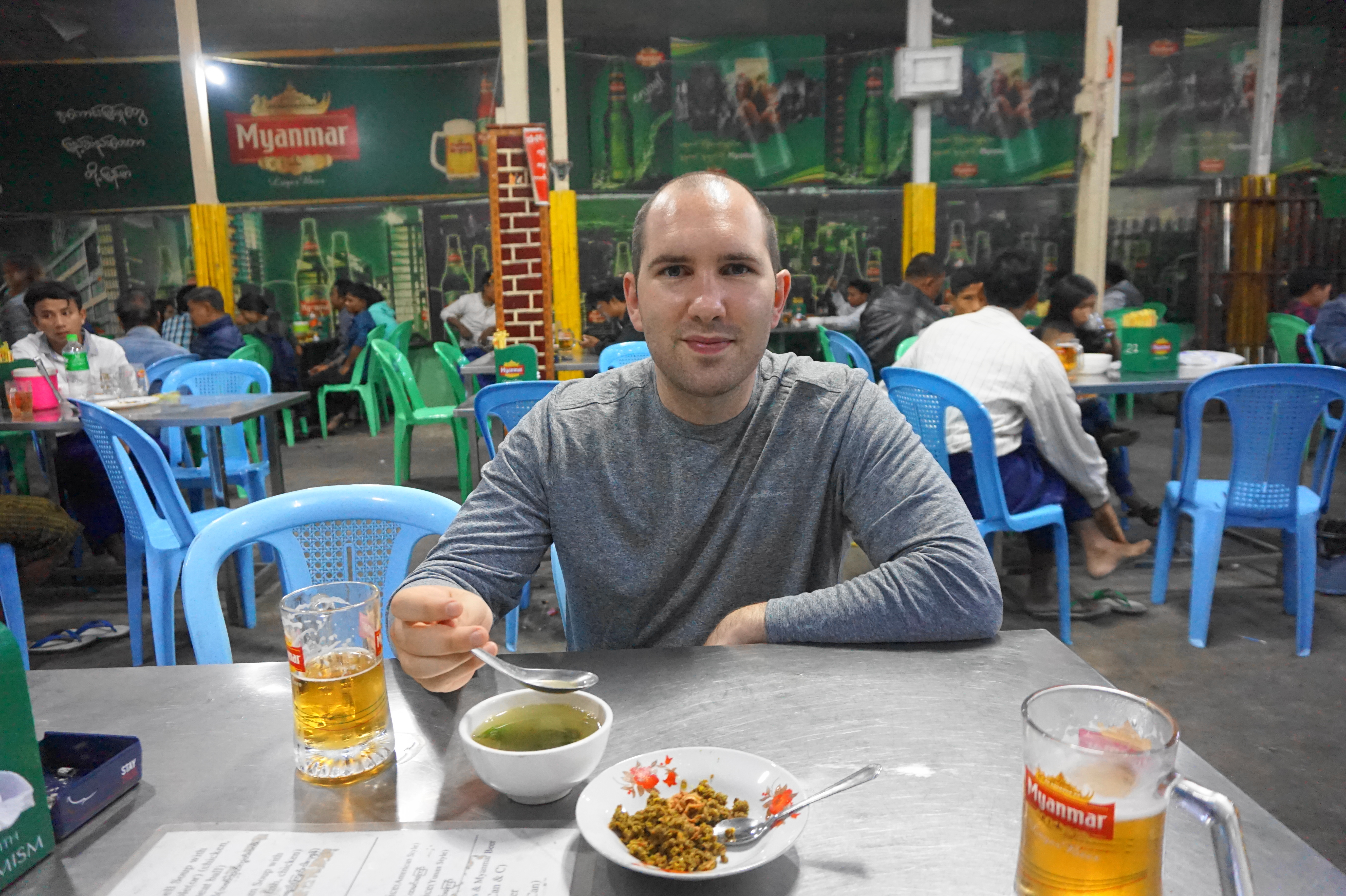 were men. Never shying away from an experience we gestured the hostess for two seats. Entering the establishment was an experience by itself. Dim lighting, walls of a lime green colour with years of grime build up, dusty fans suspended from the ceiling, and foldable furniture holding piles of empty beer glasses. Alayna loves the places I take her to. Within moments of sitting we were asked to take a selfie with a patron. We obliged and then enjoyed the rest of our beers with a side of sneaky stares. One thing we will never get used to is the way they call a waiter: puckering your lips and making a smooching sound similar to calling an animal.
were men. Never shying away from an experience we gestured the hostess for two seats. Entering the establishment was an experience by itself. Dim lighting, walls of a lime green colour with years of grime build up, dusty fans suspended from the ceiling, and foldable furniture holding piles of empty beer glasses. Alayna loves the places I take her to. Within moments of sitting we were asked to take a selfie with a patron. We obliged and then enjoyed the rest of our beers with a side of sneaky stares. One thing we will never get used to is the way they call a waiter: puckering your lips and making a smooching sound similar to calling an animal.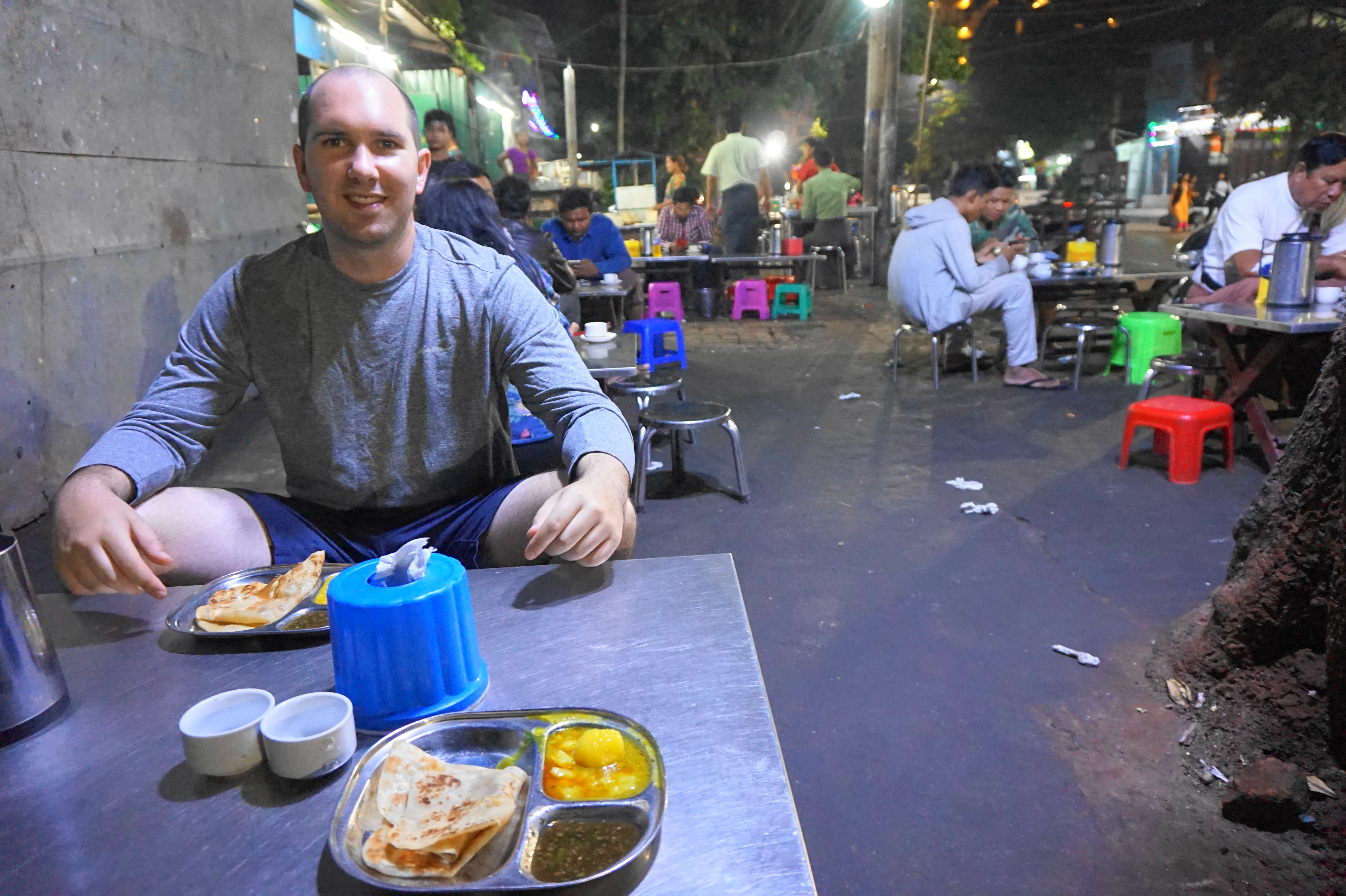
Myanmar has made a lasting impression on us already. It’s authentic and unique. It’s rapidly changing and in many ways becoming more western. We’re thrilled to be experiencing it at its modernization infancy.
